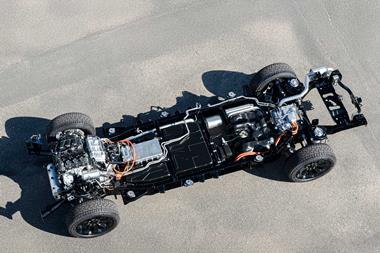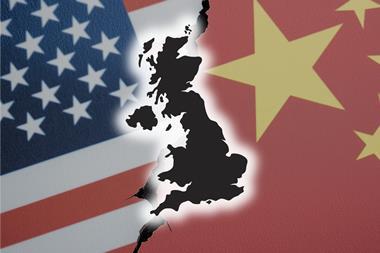 Dermot Healy spoke to Dr Luigi Lazzari, executive director (Europe-Africa) at Geico Taikisha, about the company achieving its goal of a sustainable paintshop ahead of schedule
Dermot Healy spoke to Dr Luigi Lazzari, executive director (Europe-Africa) at Geico Taikisha, about the company achieving its goal of a sustainable paintshop ahead of schedule
Geico targeted a sustainable paintshop by June 2020, yet you’ve achieved this almost three years early. How did that come about?
The sustainable paintshop has long been a key objective for Geico. The most important thing we did was to begin with a very detailed analysis of the way energy was used at that time, breaking down the different elements of the preparation and paint process, and measuring carefully the energy requirements at each stage. With this level of detailed analysis, we were able to identify the easy wins. As with any project, once you have the relevant data, you can identify the small changes that can reap the big rewards. That is what we did. Of course, as you go on it gets more difficult. However, our initial analysis helped sensitise everyone in Geico to the issue – and that helped establish it as a focus for our work throughout the organisation.
Why was that important?
Energy-saving strategies became an integral part of our work. They became its soul. Having to operate in an industry that is subject to continuous market deviations, it was very difficult to drive our customers’ attention to the cost of ownership, rather than the usual price of our plants. And energy was the biggest annual expense to run paintshops, as well as the contaminating factor.
So to secure the necessary investment and commitment to energy reduction was both a technical and commercial challenge. Energy reduction requires a longer-term perspective than is usual and it often requires working across departmental boundaries. Everyone wants to protect their own budgets and evaluate investment in terms of their own concerns, so we had to make sure our projections and estimates of benefit could be rigorously justified.
We had to encourage a broader approach to evaluating investment and convince customers that our plans and projections made good commercial sense, as well as having very obvious social and environmental benefits. But once the project got embedded into our thinking, and we were able to show the benefits, we made good progress.
You already stated that ‘Energy Independence Day’ could also have been achieved by dramatically increasing the renewable energy inputs rather than reducing energy usage.
I did say you could approach it with vast swathes of solar panels, but that would be pointless. Our concentration had to be on reducing the energy requirements and, of course, our customers’ energy suppliers are separate, independent businesses, so it is for them to determine the mix of energy they supply. That is their business. Our job is to reduce energy requirements as best we can for our customers.
The significance of the ‘Energy Independence Day’ is to have achieved that with a conventional commercial mix of energy inputs. After all, nobody wants to surround their paintshop with two football pitches full of solar panels.When we set the target of Energy Independence, paintshop energy requirements were around 900kW/hour per body. We have engineered significant reductions: over 70% reduction in pretreatment and electrocoating, 70% in the sealing line, and over 80% in the spray booth and paint application. Each saving is the culmination of careful design work and process development, so it represents not just energy saving, but brings improvements in quality, cost reduction and enhanced flexibility as well. These are key considerations for our customers. With an overall energy reduction of 70%, it becomes realistic to expect to source the required 30% from renewable resources.
Where were gains made?
It was a combination of many things. All our new products and systems introduced in the last decade have brought with them energy-saving benefits. Much of it isn’t especially complex or sophisticated, but it involved thinking rigorously about how each process can best be configured: reducing footprint, controlling waste heat and limiting unnecessary movement are all things that brought benefits. The move to primerless solutions; the J-Hive system reducing footprint and air volumes within the booths; the Lean Dip process; new heat pump technology; the use of a single robot application to both interior and exterior; sophisticated drying and curing processes that were much more efficient and less energy intensive – all these things played a part.
So a combination of initiatives and changes?
But another thing you must understand is that when we looked at energy usage, it was not always about changing processes or complex technologies. Much could be achieved by careful scrutiny of the way existing operations were managed and scheduled. Businesses often establish procedures that have relevance for one set of circumstances and somehow these become the established way of doing things in all circumstances: of course, they are not always ideal or appropriate. We found that significant gains in efficiency and energy utilisation could be achieved with existing equipment and processes, just by altering scheduling and the like. This is where the careful analysis of the actual patterns of usage became important.
Geico has always cultivated a culture of innovation. Do you think this has this proved relevant to the early achievement of the sustainable paintshop target?
Yes – very much so. It has proved very important precisely because solving problems like those presented in energy reduction is all about developing solutions in complex sets of circumstances. This requires a flexibility of thinking. We know the culture of an organisation can significantly affect the ability of all our staff to respond. Geico has put a lot of effort in to creating a climate that we believe fosters ingenuity and encourages wide-ranging analytical thought. Energy Independence Day project undoubtedly benefited from this. Our engineers and design colleagues have been able to explore possibilities with a confidence that would perhaps not be there in a more conventional company.
Now this target has been achieved, what new challenges will Geico will be concentrating on in the future?
Undoubtedly the developments around Industry 4.0 will dominate the future. In fact, we have a privileged position here, as before anyone was talking about Industry 4.0, we had started already to digitalise our plants to allow our customers to merge over our plants in a much more efficient way, both in energy consumption and augmented maintenance tools. But we still feel we are far away from what this new era could bring to us and the industry.
It’s fair to say nobody can be sure where these developments may lead, but certainly it is the area where we must look for developments. With our Smart Paintshop concept, our task is to find the optimum mix of human and robotic inputs into any particular process.
Industry 4.0 has had a big impact and Geico has now developed a structure of linked elements that offer our customers a real benefit. The prospect, for example, of the Paintshop ‘self-learning’ and adapting processes almost in an autonomous way is an intriguing one. With digital data and integration of systems, it has the potential to revolutionise plant operation and management. It will certainly help our customers to reduce consumption and improve productivity further. The continued development of our Smart Paintshop concept is our task for the future.
www.geicotaikisha.com






































